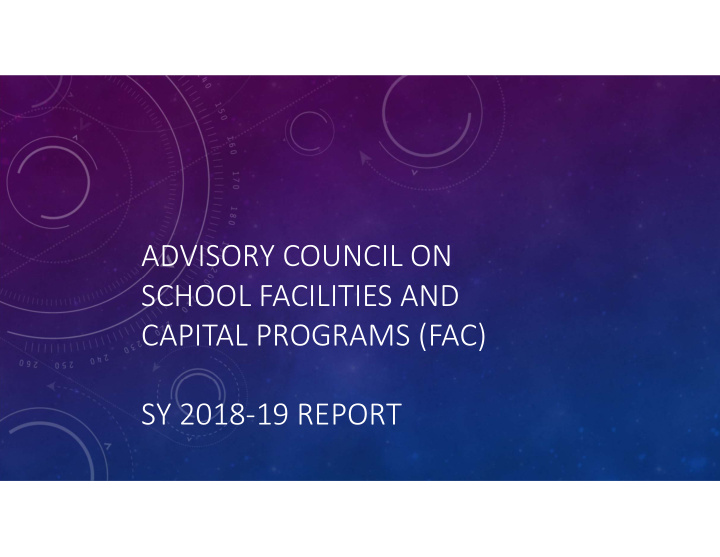



ADVISORY COUNCIL ON SCHOOL FACILITIES AND CAPITAL PROGRAMS (FAC) SY 2018‐19 REPORT
• FAC aims to provide a county‐wide perspective that puts each decision into the context of how it impacts the capacity and facility needs for the entire school division. Our discussions focus on the impacts of our growing enrollment on our school facilities and on planning processes that would best prepare APS for future growth
INVOLVEMENT • Projections • Amazon • Understanding our capacity crunch through data visualizations • MC/MM • Elementary School Boundaries • Recommendation to expand the AFSAP • Ed Center Renovation • Common Spaces Subcommittee • Swing Space • Stream Lining Use Permit Conditions and Processes
RECOMMENDATIONS • Boundary Decisions • Consider adopting a more routine schedule of boundary review and adjustment; one that is responsive to localized and system‐wide growth with a goal of maximizing efficiency and ensuring that no single school ends up compromising instruction due to over‐enrollment. • Build upon the Facilities Optimization Study and establish an fair and comparable maximum number of students who can attend each APS school and identify areas of the County that have imbalance between the number of proximate elementary students and the number of available neighborhood seats (accounting also for common space constraints).
• Expanded AFSAP/APS Master Plan • Create the most effective planning tools that best prepare APS for expected enrollment growth while maintaining the high‐quality facilities and excellent educational standards we expect of our school system • We recommend that APS continue to work toward the goal of expanding the AFSAP beginning this year and should work to become a completed document by 2021.
• We recommend that some of the work that we focused on this year be included within the AFSAP: • The FAC Subcommittee on Common Spaces data which can be used to inform a revised Facilities Optimization Study, help create criteria or considerations for a Facilities Needs Assessment and/or help to define available capacity at APS schools. • New maps illustrating projections and location of enrollment growth within the County • Capacity and Utilization Chart showing all ten years of projections at individual schools • Criteria and considerations for swing space • Define Educational Specifications as they apply to new construction and current facilities
• We also recommend continuing to engage in the necessary conversations with the County and with JFAC to engage in the process of establishing collaborative planning tools that best prepare APS and the County for future growth
• Sites for New Schools and Swing Space • Given that projections this year estimated a ‐2,400 seat deficit at the elementary school level and a 1,000 seat deficit at the middle school level by 2028, it is critical to begin identifying sites for new schools and to consider APS sites that could be repurposed or renovated to add capacity and create amenities for school use. • It is also important to identify sites for swing space for elementary schools so that we can renovate, add to or repurpose some of our existing facilities. This could either be a temporary space that offers classroom, common space, and outdoor space for up to 600 students or a space that could potentially become a new school after it is used several times for swing space while other facilities are under construction.
• Streamlining Use Permits and Conditions • We recommend that APS continue to work with the County to investigate ways to make every process more efficient as APS student enrollment continues to grow. • We also reiterate our recommendation to continue efforts to reduce the total time it takes to complete a capital project from five years to four . •
PRIORITIES FOR NEXT YEAR • Primary focus will be on the upcoming CIP. • We will continue to investigate and examine the elements of our planning processes and tools to ensure they are effectively and efficiently defining the needs of our growing school division. We will look at the data to help define the facilities needs of our school system and to help define priorities such as which school level has the highest capacity need and where that need is located within the county. • Expanded AFSAP • We will continue to provide input on and monitor the work to develop a comprehensive APS planning document by 2021.
CLOSING • We encourage the School Board to lead the community in acknowledging the pressures of our enrollment growth and continue to do its best to further communication with the public about how this impacts our facilities and our entire school system. The FAC encourages APS to continue to “show its work” and to fully explain to the public how and why they reach decisions and why other alternatives were not chosen.
THANK YOU • We would also like to thank the staff that dedicated so much time and effort to support our committee: • John Chadwick, Lisa Stengle, Michael DePalma, Robert Ruiz, Zach Larnard, Jeff Chambers, Jim Meikle, Lionel White, Michael Freda • We would also like to acknowledge several departing members: • Laura Saul Edwards: Served a full 6‐year term on the FAC, FAC liaison to CCPTA, FAC liaison to Lee Highway Community Study • Eric Harold: Served a full 6‐year term on the FAC, FAC liaison to SAWG, informal secretary‐ taking the best meeting notes • Lois Koontz: Served 4 years on the FAC, FAC liaison to Education Center Renovation BLPC, Led the FAC Subcommittee on 1300 High School Seats, FAC liaison to CCPTA • Steve Maguire, Maureen Fanguy
Recommend
More recommend